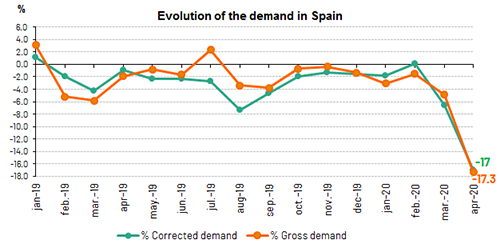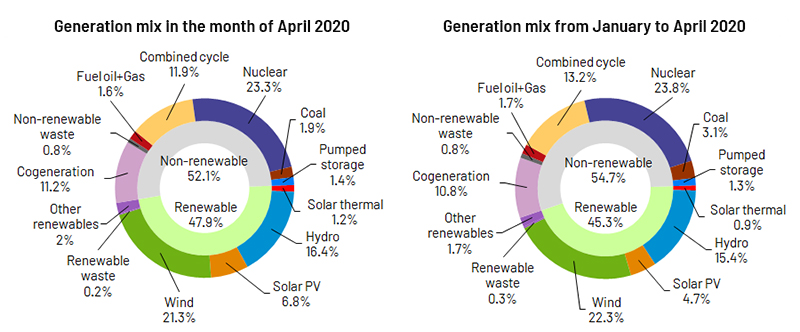For 40 years, we've been driving our country's economic and social progress. Four decades shaping Spain.
Demand for electricity in Spain falls 17.3% in April
- 47.9% of the monthly generation came from renewable sources and 72.6% was produced from technologies that do not emit CO2 emissions.
- Demand for electricity in the Balearic Islands fell by 27.6% and in the Canary Islands by 20.3% compared to the same month in 2019.
Following the usual calendar for the communication on the evolution of the monthly demand for electricity, Red Eléctrica de España publishes the data corresponding to the month of April; the first complete month under the state of emergency due to COVID-19, in which the drop in economic activity which began on 15 March continued. In this context, national electricity demand for April is estimated at 17,104 GWh, 17.3% less than that recorded for the same month of the previous year. After having factored in the influence of seasonal and working patterns, the figure fell 17% compared to April 2019.

In the first four months of 2020, demand is estimated at 82,737 GWh, 6.5% less than in the same period in 2019. Again, after having factored in the influence of seasonal and working patterns, demand is 6.2% lower than in the same period last year.
In April, according to data estimated at the time of this press release, generation coming from renewable energy sources represented 47.9% of the total production. From January to April, overall renewable generation reached 45.3% of the total electricity generated.
72.6% of electricity generation during April was obtained using technologies which produce zero CO2 emissions.

Demand for electrical energy in the peninsular electricity system falls 17%
Demand for electrical energy in the peninsular electricity system in the month of April is estimated at 16,191 GWh, 17% lower than that recorded in the same month last year. After having factored in the influence of seasonal and working patterns, the demand for electricity dropped 16.7% compared to April 2019.
In the first four months of 2020, the demand for electricity on the Spanish peninsula is estimated at 78,319 GWh, 6.4% less than in 2019. Once again, after having factored in the influence of seasonal and working patterns, demand is 6.2% lower than that registered in the same period last year.
During the month, according to data estimated at the time of this press release, 49.7% of the peninsular generation came from renewable energy sources and 75.7% was obtained using technologies which produce zero CO2 emissions. For its part, wind energy stood at 3,672 GWh, a figure that is 20.1% lower than that registered in April last year and contributed 22% to the generation mix.
Demand for electricity in April decreased 27.6% in the Balearic Islands and 20.3% in the Canary Islands
In the Balearic Islands, the demand for electricity in April is estimated at 323,296 MWh, a value that is 27.6% lower than that registered in the same month last year. After having factored in the influence of seasonal and working patterns, the figure decreased by 27.6% with respect to April 2019. In the first four months of 2020, overall demand in the Balearic Islands is estimated at 1,586,386 MWh, 10.7% less than in 2019.
Combined cycle, with 78.3% of the total, was the leading source of electricity generation in the Balearic Islands, where renewable technologies and those which produce cero CO2 emissions, accounted for 6.4%. Coal-fired generation was not used to produce a single MWh in April, a trend that has been maintained since the beginning of the year in the Balearic Islands system.
In regard to the Canary Islands, electricity demand is estimated at 558,619 MWh, 20.3% down on that registered in April 2019. After having factored in the influence of seasonal and working patterns, the figure drops by 20.2% with respect to the same month last year. So far in 2020, overall demand in the Canary Islands is estimated at 2,701,096 MWh, a decrease of 6% on the same period last year.
During April and according to current estimated data, combined cycle was the leading technology in the Canary Islands generation mix, with a contribution of 45.3%. Renewables and zero-emission technologies accounted for 14.3% of the generation on the Canary Islands.
Consult our Daily Balance Report for more information on the National, Peninsular, Balearic Islands and Canary Islands electricity systems as at the close of April.












